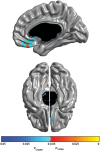Anxious/depressed symptoms are linked to right ventromedial prefrontal cortical thickness maturation in healthy children and young adults
- PMID: 23749874
- PMCID: PMC4193463
- DOI: 10.1093/cercor/bht151
Anxious/depressed symptoms are linked to right ventromedial prefrontal cortical thickness maturation in healthy children and young adults
Abstract
The relationship between anxious/depressed traits and neuromaturation remains largely unstudied. Characterizing this relationship during healthy neurodevelopment is critical to understanding processes associated with the emergence of child/adolescent onset mood/anxiety disorders. In this study, mixed-effects models were used to determine longitudinal cortical thickness correlates of Child Behavior Checklist (CBCL) and Young Adult Self Report Anxious/Depressed scores in healthy children. Analyses included 341 subjects from 4.9 to 22.3 year-old with repeated MRI at up to 3 time points, at 2-year intervals (586 MRI scans). There was a significant "CBCL Anxious/Depressed by Age" interaction on cortical thickness in the right ventromedial prefrontal cortex (vmPFC), including the medial orbito-frontal, gyrus rectus, and subgenual anterior cingulate areas. Anxious/Depressed scores were negatively associated with thickness at younger ages (<9 years), but positively associated with thickness at older ages (15-22 years), with the shift in polarity occurring around age 12. This was secondary to a slower rate of vmPFC cortical thinning in subjects with higher scores. In young adults (18-22 years), Anxious/Depressed scores were also positively associated with precuneus/posterior cingulate cortical thickness. Potential neurobiological mechanisms underlying this maturation pattern are proposed. These results demonstrate the dynamic impact of age on relations between vmPFC and negative affect in the developing brain.
Keywords: Child Behavior Checklist; anxiety; brain development; depression; magnetic resonance imaging.
© The Author 2013. Published by Oxford University Press. All rights reserved. For Permissions, please e-mail: journals.permissions@oup.com.
Figures




References
-
- Achenbach TM. Manual for the Child behavior Checklist/4-18 and 1991 Profile. Burlington, VT: University of Vermont Department of Psychiatry; 1991.
-
- Achenbach T. Manual for the young adult self-report and young adult behavior checklist. Burlington, VT: University of Vermont. Department of Psychiatry; 1997.
-
- Achenbach T, Rescorla L. Manual for the ASEBA school-age forms and profiles. Burlington, VT: University of Vermont, Research Center for Children, Youth and Families; 2001.
-
- Achenbach T, Ruffle T. The Child Behavior Checklist and related forms for assessing behavioral/emotional problems and competencies. Pediatr Rev. 2000;21:265–271. - PubMed
-
- Aiken L, West S. Multiple regression: testing and interpreting interactions. Thousand Oaks, CA: Sage Publications, Inc; 1991.
Publication types
MeSH terms
Grants and funding
LinkOut - more resources
Full Text Sources
Other Literature Sources
Medical

